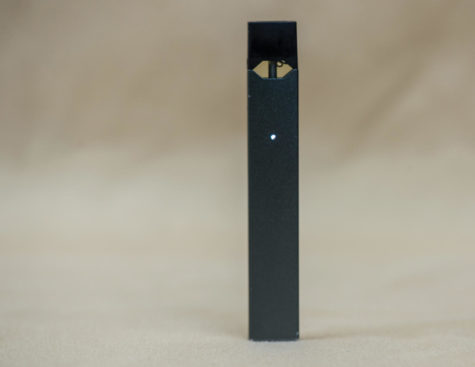Up in Smoke
6 MIN READ
Be the generation to end smoking.” This is a popular campaign slogan of the organization Truth, whose goal is to end teen smoking through the spreading of facts and information. Their advertisement campaign is targeted at teenagers and has an active presence in media like TV, Spotify and Soundcloud, just to name a few. However, many teens deem these advertisements ineffective because alternative nicotine uses like vaping are not acknowledged as a part of the problem. Boasting the claim that only six percent of teens smoke cigarettes, awareness advertisements step around a real and rising problem facing teens today: nicotine use through vaping. There is a discrepancy, however, between the intent to create e-cigarettes; Big Tobacco taking advantage of e-cigarettes as a gateway into more severe tobacco use, and Pax Labs — among other e-cigarette companies — that hopes to wean people off of tobacco use.
Big Tobacco’s decline has been met by the rise of independent e-cigarette companies, such as Pax Labs — manufacturers of the JUUL — that generally aim to provide a cigarette alternative for adult smokers. Big Tobacco’s mission to provide a gateway into cigarette smoking through e-cigarettes causes companies like Pax Labs, who are trying solely to provide a tobacco-free alternative, to seem valiant in their intent. However, this pursuit is lessened by the staggering fact that its products have proven to be immensely appealing to minors who in large part don’t or wouldn’t otherwise use nicotine products.
The Fall of Big Tobacco
Long before JUULs and vapes, teens and adults across the globe regularly purchased and smoked cigarettes. Tobacco companies used targeted, misleading and intelligent marketing, using teens and athletes in their advertisements, contracting endorsements from doctors and dentists, infiltrating sponsored game shows,
offering Christmas and holiday bundles and purchasing billboards and magazine covers to promote their products. Their tactics were extremely successful— nearly half of American men and a quarter of American women picked up smoking between the 1950s and 60s, according to a Surgeon General’s report.
Prior to the discoveries of the consequences of tobacco use, 43 percent of Americans smoked according to the same report. In the 1970s, the US Government banned Big Tobacco ads from TV and radio, and mandated warning labels on cigarette packages as the negative health effects of tobacco use became widely known. Their cancerous effects became more apparent, and people across the globe started putting down their cigarettes. By 1988, all U.S. commercial flights were tobacco free. From 2005 to 2009, the total number of Americans smoking cigarettes dropped from 21 percent to 15 percent, according to the Center for Disease Control and Prevention (CDC). As tobacco companies’ sales began to fall, the invention of the e-cigarette was catalyzed. Many tobacco companies were able to give a slight revival to their dying industry. This coincided with the birth of many small e-cigarette companies, like Pax Labs, which have been growing largely without FDA supervision ever since.

Teen consumption
Due to the accessibility of products like the JUUL, vaping is no longer a niche hobby among teens. According to the CDC, an estimated 16 percent of high school students vaped at least once a month in 2015, nearly double the amount of students who smoked cigarettes. While many focus on the near extinction of teen smoking, a clear, yet unrecognized, transition seems to be occurring. With the death of the cigarette comes the rise of the JUUL.
While cigarette companies were once able to disguise the detrimental health effects of their products, there are now many organizations like Truth and The Real Cost working to end teen smoking with well-known campaigns to deter tobacco use. However, vape companies continue to buy billboards; for instance in spring 2015, Pax Labs purchased a 12 unit billboard display that loomed over Times Square. These businesses also spend millions of dollars on online advertisements.
An increase in the money used to advertise nicotine products increases the number of teens who use said products. E-cigarettes appeal to the masses with their sleek and simple packaging; publications including Wired and Men’s Fitness have nicknamed the JUUL “the iPhone of e-cigs.” Considering that the minds behind Pax Labs graduated from the same Stanford design program as many Apple designers, this comes as no surprise.
Not only have their advertisements attracted the curious eye of the nation, they have captured popular culture. Their compact, sleek, and subtle nature makes them easy to conceal, and the convenience of the USB Charger make them the ideal choice for teens. While many see it as a joke, nicotine addiction is an issue many teens now face. A study at UCSF found that even adolescents who do not display risk factors common among cigarette smokers are using e-cigarettes. Through targeted advertisements and a pervasive hold on popular culture, America’s youth is once again getting hooked on nicotine.
Health implications
The negative health effects of cigarette-smoking have become common knowledge thanks to research-based education efforts. Bad breath, bad skin, smelly clothes and cancer are all deterrents that aid in keeping teen cigarette-smoking levels low. Few people, though, have a similar objection to the use of nicotine through vaping. Appealing design, cool flavors and a lack of information on repercussions have made many turn to an e-cigarette instead of a traditional one. Teens who are apprehensive about the health effects of cigarettes often turn to a vape or JUUL because they are “healthier.” However, e-cigarettes can be just as harmful as regular cigarettes. In a 2014 study, by the Journal of the American Medical Association (JAMA) Internal Medicine at University of California San Francisco, found that e-cigarettes can produce 15 times the amount of cancer-causing formaldehyde that cigarettes do. The lack of awareness about the health repercussions is causing a transition that is swaying the statistics about teen smoking. Many awareness organizations are focused on cigarette smoking while the need for intervention lies among teens who regularly vape — an abundance that nearly doubles those who are smoking. Additionally, a larger issue looms. Teens who use nicotine and vape products are four times more likely to start smoking in the next year, according to the University of Michigan’s Institute for Social Research.

Why this matters
Teens across the nation are regularly using nicotine products that can, and will, negatively impact their future. In the same way the world turned away from the cancerous cigarette, the world will hopefully turn away from the JUUL, too. Companies like Pax Labs have captured the American teen through misleading advertising, sleek design and sweet flavors. Although they no longer have endorsements from doctors like the cigarette companies of the past, their grasp on popular culture proves similarly effective. Teens addicted to nicotine and unable to escape are more likely than other teens to use cigarettes in the future. But there is hope.
Research by doctors at the University of California San Francisco shows that the elimination of flavored e-cigarette varieties effectively deters a great portion of youth e-cigarette users — 96 percent of whom begin e-cigarette use with flavored products, according to a study looking at high-school and college students in Texas— while not largely affecting adult users, who primarily use tobacco-like flavors. A recognition of history can help prevent the issues presented by Big Tobacco; vape companies are deceiving the world, the same way Big Tobacco did 60 years prior by avoiding research and sidestepping proven facts to promote their products. They are fostering a society in which youth nicotine addiction and use is commonplace, it is acknowledged that the industry of e-cigarette is following the same path as Big Tobacco. Mississippi Attorney General Mike Moore made a statement in 1995 that still rings true: “This industry, in my opinion, is an industry who has perpetrated the biggest fraud on the American public in history,” he said. “They have lied to the American public for years and years. They have killed millions and millions of people and made a profit on it.”






